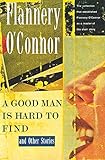Flannery O’Connor is a master of the American short story, joining since her untimely death in 1964, Hawthorne, Poe, Hemingway, and Faulkner in the literary canon. Now a fixture in textbooks and collections, she composed on an old typewriter with bookshelves nearby of modern fiction, philosophy, and theology unique among American writers. The novels of William Faulkner, the American Virgil, beside the writings of the angelic doctor Thomas Aquinas testified to wide study. Here are some interesting observations I discovered in editing Good Things Out of Nazareth.
1. O’Connor was amused about Ronald Reagan possibly acting in one of her stories.
The prospect was long before Reagan took office and years before he was a “B” actor in Hollywood. O’Connor received word that “The Life You Save May Be Your Own” was being shopped around for an actor to play the part of the notorious, one-armed vagrant, Mr. Shiftlet. The notion of Reagan playing the part of a memorable villain was hilarious to O’Connor. Reagan playing the part did not come to fruition. O’Connor would have been been amazed that the Ronald Reagan she saw on television in the 1950s went on to become the celebrity President.
2. O’Connor actually witnessed Soviet “collusion” in the late 1940s.
She was an ardent theological anti-communist and believed Marxism to be a theological heresy. While O’Connor was in residence at the Yaddo Artists’ Colony in New York, she had become friends with another writer in the community, the poet Robert Lowell. Lowell exposed infiltration of Yaddo by a communist spy while O’Connor was there. The FBI actually had been surveilling the community when Lowell went public with his anti-communism. O’Connor was steadfast in her support of Lowell. He and O’Connor would leave Yaddo but remained friends. O’Connor provided stability to Lowell’s sometimes erratic personality.
3. A Georgian, O’Connor resisted being labeled a Southern writer.
In a letter, O’Connor asks a professor friend who had been lecturing on Southern literature, “What is that?” In 1956, O’Connor wrote another friend about her teachers, “They were agrarians—such people as John Crowe Ransom and Robert Penn Warren…That was all part of what is now pompously called the Southern literary renascence.” Walker Percy, from Louisiana, shared her aversion to literary categorization. Upon publication of his existential novel The Moviegoer, Percy wrote his editor in April 1962, “And Knopf was such a grand old house before you had truck with dirty writers. Can’t speak for Updike or Mailer but mine is the worst of all because it pleases no one. It’s too Yankee to suit Southerners, too vulgar to suit Catholics, too Catholic to suit humanists, out but not way out.”
4. O’Connor may have objected to the way her stories have been studied.
“A Good Man Is Hard to Find,” for example, has appeared in anthologies for many years. She may have not intended it be studied in isolation divorced from the short story cycle in which it first appeared. While the publication of individual stories has increased O’Connor’s popularity, the reading of the stories out of sequence of a cycle may have undercut her intentions. In several letters O’Connor conceives of the collection A Good Man Is Hard to Find and Other Stories (1955) as an exposition of the seven deadly sins modeled on Dante’s Purgatorio. Sequencing of the stories is essential. The letters reveal O’Connor intended larger contextual revelation of a specific order. This vital principle better enables readers to understand her fiction is not just about roadside killings, hangings, and gorings.
5. O’Connor’s voting preferences remain obscure.
Like a young Bill Clinton, O’Connor listened to an exciting speech delivered at the 1956 Democratic convention by Governor Frank G. Clement of Tennessee. The governor criticized President Eisenhower for too much golf, a topic that remains popular. In a letter from 1960, O’Connor defends John Kennedy against anti-Catholic paranoia. Other letters reveal some of O’Connor’s politically active friends embraced an outlook not mentioned in Democratic debates today. In the 1950s and through the election of Kennedy there existed a vibrant tradition of the “yellow dog Democrat.” Such Democrats would vote for a “yellow dog” rather than a Republican. “Yellow dog” Democrats had heard vivid recollections of Republican war policy during the Civil War and Reconstruction, including dismal tales about “Mr. Lincoln’s army” and General Sherman’s “smoky march” in 1864 through Georgia and South Carolina. O’Connor’s teachers and friends (as well as William Faulkner) had all learned much of their history and political loyalties from Civil War veterans themselves. O’Connor could be irreverent about ancestor worship, however, evident in the story, “A Late Encounter With the Enemy” and the senile character, “General” George Poker Sash.
6. O’Connor’s steady reading of Catholic theologians changed in the final months of her life.
Several friends sent her books by C. S. Lewis. While in an Atlanta hospital O’Connor writes a professor friend: “it’s a great pleasure to be reading C. S. Lewis on the subject [of prayer]. And I was liking the one [book] on miracles too. That stuff is right up my alley. I couldn’t close the book and make anybody believe in miracles but what his kind of a book does is something for the imagination.” Lewis strengthened O’Connor right up until the end. She was too weak for a manual typewriter and used an electric one and hid “Judgment Day” under her pillow from her doctors. O’Connor discovered the apologetic power of C. S. Lewis—the core “mere Christianity” that has comforted and strengthened many in all manner of trials and tribulations. O’Connor read him like countless others, as an apologist who provided spiritual strength.
This piece was produced in partnership with Publishers Weekly and also appeared on publishersweekly.com.











